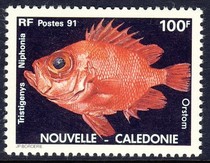Japanese bigeye
The Japanese bigeye lives in the reef-associated, marine, depth range 80 - 100 m environment.
The annual quality rejection rate average of Japanese bigeye tuna was 6.04% and ranged from 1.3% to 12.4%. The overall mean rejection rate of bigeye tuna from the Taiwanese fleet was 7.1%. The average weight of rejected fish was significantly lower than market grade fish. More
The striped Japanese Bigeye, Pristigenys niphonia is offered from time to time from the Indo-Pacific, as is the Popeye Catalufa, Pristigenys serrula (Gilbert 1891), from the eastern Pacific, generally from Mexico. The latter pictured here in an aquarium. More
Common names
Baga-baga in Waray-waray
Bagang buwan-buwan in Cebuano
Beau clair du large in French (français)
Beau-clair du large in French (français)
Bukaw in Waray-waray
Cá Trác m?t to in Vietnamese (Tiếng Việt)
Cá Trác mắt to in Vietnamese (Tiếng Việt)
Fura-vasos japonês in Portuguese (Português)
Fura-vasos japonÍs in Portuguese (Português)
Gelama in Malay (bahasa Melayu)
japanese bigeye in English
Japanse grootoog in Afrikaans
Kuruma-dai in Japanese (日本語)
Kurumadai in Japanese (日本語)
Lolong bara in Malay (bahasa Melayu)
Mo-ong in Davawenyo
Nĭ dà yǎn diāo in Mandarin Chinese
San gaa in Malay (bahasa Melayu)
Siga in Tagalog
Tǔng-gǔl-dom in Korean (한국어)
White-striped big-eye in English
Whiteband bigeye in English
пристигенис in Russian (русский язык)
严公仔 in Mandarin Chinese
嚴公仔 in Mandarin Chinese
大鱗大眼鯛 in Mandarin Chinese
大鳞大眼鲷 in Mandarin Chinese
日本拟大眼鲷 in Mandarin Chinese
日本擬大眼鯛 in Mandarin Chinese
日本鋸大眼鯛 in Mandarin Chinese
日本锯大眼鲷 in Mandarin Chinese
둥글돔 in Korean (한국어)


Family : Priacanthidae
Genus : Pristigenys
Species : Pristigenys niphonia
Authority : Cuvier, 1829
